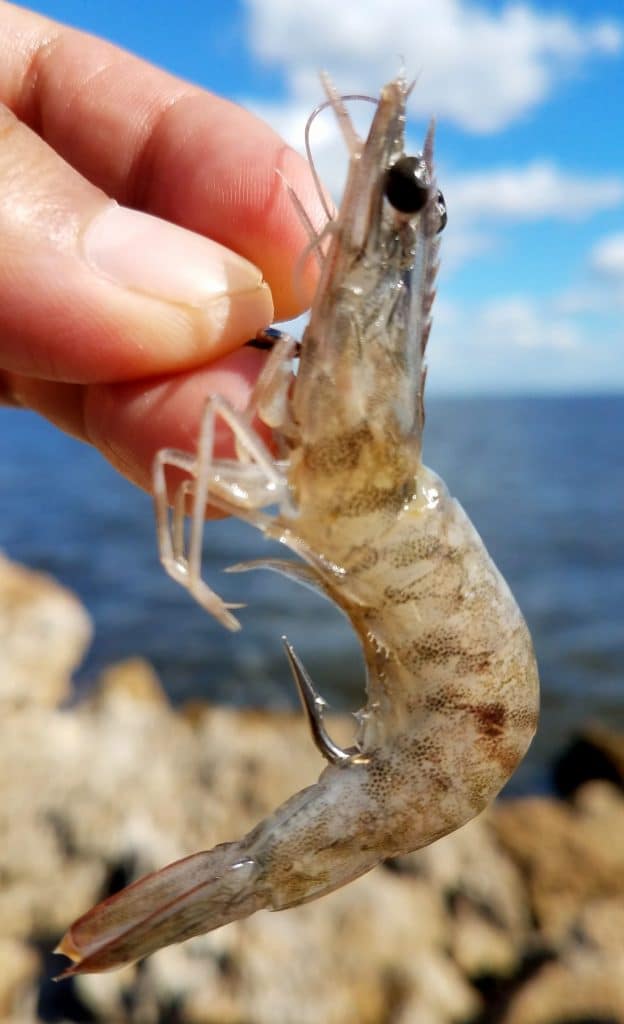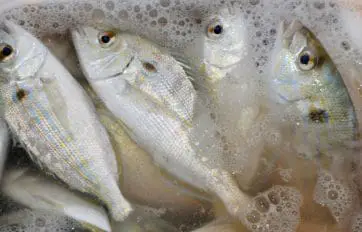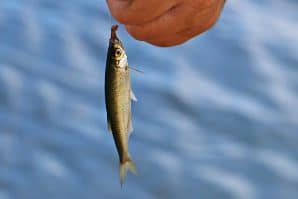Live bait is arguably the most effective type of bait to use for surf fishing (also known as beach fishing). The best types of live bait for surf fishing are sand fleas, shrimp, pinfish and mullet. You’ll learn about each of these, including how to hook them and what types of fish they attract. We’ll also explain how to handle the bait so that your live bait doesn’t become dead bait.
Sand fleas

Sand fleas, which are also known commonly as sand crabs or mole crabs, are a small type of crustacean that can be found along many surf beaches. They are a natural prey for the species that are in the area. Although there are different types of sand flea available, it is better to use the species of sand flea that is prevalent in the area. The ‘local’ fish will be used to eating that type of sand flea.
How to catch sand fleas for bait
The best way to catch sand fleas is to visit the beach on low tide as the areas that they burrow and live in become visible. The angler needs to look for a small entrance hole that they have used and it is a case of extracting them either by digging with a shovel, using a rake or simply scooping them out with hands.
Keeping sea fleas alive
Once you catch enough sand fleas for a day’s fishing, it is important to keep them alive. The best way to do this is by adding them to a bucket and covering them in a thin layer of moist sand. It is important to keep the sand moist as their gills need to remain wet so dry sand will cause these to dry out and the fleas will soon die. During warm weather it is also advisable to cover them in a damp cloth as this will help prevent the sand from drying out.
Hooking a sand flea
When hooking a live sand flea, care must be taken as it must still be able to move freely. Take the hook, a size 1 long shank version being ideal, and simply hook it lightly through the back of its body and out through the shell. Some anglers even add a few small orange beads to the line as this is the color of the sand fleas’ eggs which can help attract inquisitive species.
Best rig for sand fleas
The best method to fish with a sand flea in the surf is by using the fish finder rig. The angler can place the rod in a sand spike or hold the rod and feel for bites.
What fish are attracted to sand fleas?
A wide range of fish will happily eat a sand flea including pompano, mullet, croaker, sheepshead, redfish, flounder and striped bass.
Shrimp
Another live bait that works amazingly well is shrimp. Shrimp can be purchased at your local bait shop or easily be collected prior to fishing.

Catching shrimp for bait
The best way to gather live shrimp is by using a cast net. Wade out into the surf and throw the net, leaving it to settle on the bottom before retrieving it. Alternatively hang a light, such as a lantern, from a pier or bridge after dark so that it shines on the water. The shrimp will come to the surface to investigate the light and can easily be scooped up with a long-handled net. Adding a little shrimp meal as bait can also help attract shrimp into the area.
How to keep shrimp alive
Keep shrimp alive by using a live bait bucket with an aerator. The aerator pumps oxygen into the water meaning you won’t have to replace the water nearly as often.
Make sure to hook the shrimp correctly to keep it alive and behave naturally for as long as possible. Run the hook through the last section of the tail which will allow it to behave in a natural manner and also through its head. Hooking through the central part of the body allows its legs and tail to behave naturally.
Best rigs for baiting shrimp
When using live shrimp as bait, you can either use a bottom rig such as the fish finder rig, a double dropper bottom rig that uses two separate hooks, so two baits can be fished at the same time. Another option is a fireball rig that uses colored floats on the dropper line which float and lift the bait off the bottom. You can also fish the shrimp in the surf, if conditions allow, using a bobber.
Shrimp are the best live bait for any sheepshead rig.
What fish are attracted to shrimp?
Most fish that live in the surf will be partial to a live shrimp, but they are especially effective when targeting mackerel, bass, redfish, snook, permit and speckled trout.
Pinfish
Pinfish are also a good choice as they are abundant and extremely hardy compared to other common baitfish. Pinfish, also known as bream, porgie, butterfish or sand perch can be found singly or in large groups over mangrove areas and in areas with rich vegetation.

Catching pinfish for bait
To catch pinfish, look for areas where they inhabit such as grass flats or structure. There are three main ways to go about gathering enough fish for a day’s fishing. The quickest and easiest is by casting a net.
You can also catch pinfish by using a light rod and reel and rigging it with a sabiki rig, which is a series of small hooks with feathers or tinsel tied to them, with a sinker added to the end.
They can also be caught by using a pinfish trap. Simply add some bait such as fish strips into the trap and lower down into areas where pinfish are present for around two hours. They will swim in through openings in the trap and not be able to find a way out.
Keeping pinfish alive
To keep pinfish alive and in good condition whilst fishing, keep them cool in an aerated bucket. It also helps to do a 25% water change every two or three hours as fish waste causes ammonia build-up which can become toxic to the pinfish.
How to fish with pinfish bait
Pinfish can be fished either underneath a bobber, on a bottom rig with a sinker such as a fish finder rig or, if fishing close in when the angler wants the pinfish to swim naturally, they can be fished free lined.
Rig the pinfish through the nose when making regular casts to keep the bait in the strike zone. Pinfish can also be hooked either through the back just behind the dorsal fin or through the base of the tail, which helps them stay upright and swim in a natural manner.
What fish are attracted to pinfish?
Most predatory species that can be found in the surf zone will not refuse a live pinfish. Various snapper species such as mangrove and mutton snapper, grouper, various types of shark, snook, redfish, tarpon and jack crevalle are all attracted to pinfish.
Mullet
Mullet, commonly known as finger mullet, might be the best live bait for surf fishing. These are small juvenile mullet that are around the size of an adult’s finger and a plentiful supply can be caught or purchased from a bait shop.

Catching mullet
A fun way to catch small mullet for bait is by using tiny hooks rigged with bread, either free lined or under a small bobber. Throwing small pieces of bread in the water will attract the mullet into the area and keep them there until a ready supply has been caught.
Keeping mullet alive
Once caught, they must be kept in a well aerated bucket of clean water. As with pinfish, a regular 25% water change will help to keep this bait in good condition. Keeping the water cool is also important, so either place in the shade, cover it with a damp cloth or keep a frozen bottle of water in the bucket. The regular water changes will also help to control the water temperature.
How to fish with a mullet
The best way to hook a mullet is by hooking it through both lips which keeps it alive for longer and helps it swim in a natural manner. As with pinfish, they can be fished on the bottom with a sinker, underneath a bobber. Mullet can also be free lined for a range of species such as striped bass, redfish, snook, flounder, tarpon and mackerel.

Hello! My name is Tim and I’ve been fishing for over 30 years. I’ve learned a lot about fishing during that time and I love sharing that knowledge with others. I’m also a member of the International Game Fish Association (IGFA). Thanks for checking out the site!

